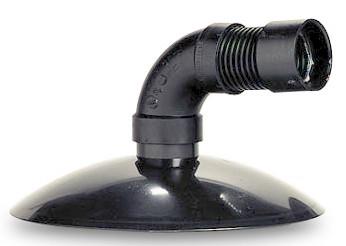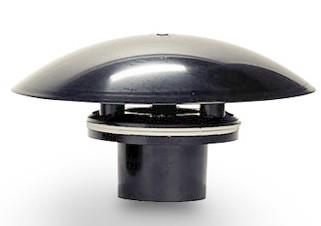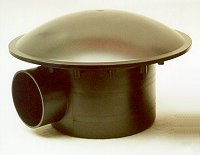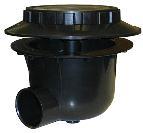| DIY Series: Buiding a Bottom Drain | ||||||||
 | ||||||||
|
Why install a bottom drain ? For the first 3 years, my pond didn't have a bottom drain. Leaves and other debris which got by the skimmer would settle at the bottom of my pond and decompose into a black muck. Eventually this black muck, commonly known as Mulm, would accumulate a depth of about 6". When fish stirred up this muck, Nitrogen bubbles would come to the surface of the pond and lower the dissolved oxygen levels. Attempting to net this muck out was quite futile. After much research I decided to drain and clean the pond, and then install bottom drains overtop of my existing liner. Draining a 15,000 gallon pond is no easy task. Luckily I already owned a 5hp gasoline powered transfer pump. The pumps rated capacity was 250 gallons per minute, and believe me they were right. It took me 4 hours to pump the pond dry, and my lawn received a good watering at the same time. I removed the muck with 5 gallon buckets. In all, I removed 40 buckets of this muck. It made great fertilizer for my flowerbeds. Next was the task of installing bottom drains. My pond is lined with 30 Mil PVC, so a liner boot wasn't an option, plus I didn't feel like tearing my pond completely apart to install the piping below the liner. What I came up with was a vacuum style bottom drains. I used a Squirrel Baffle as the intake, and 4" schedule 20 sewer pipe to carry the waste from the bottom up to the side of the pond. I connected the pipes through the liner using two bulkhead fittings and into a settling chamber. 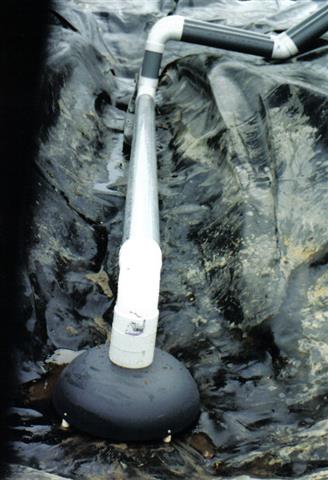
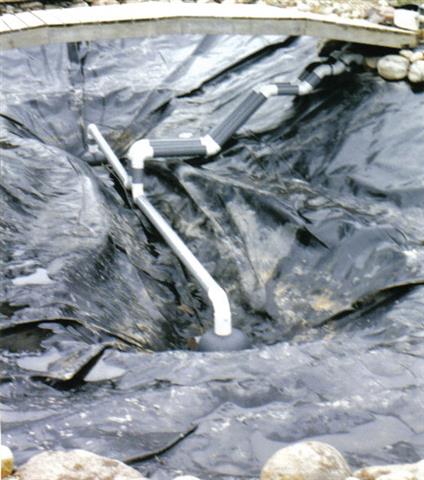
Well, the pond is ready to be refilled, but where do I find that much water ? When I built the pond 3 years ago, I filled the pond using my well, It took 3 days straight. I didn't feel like waiting that long, so I came Up with a new plan. I would use my 5hp pump to get the water from a small creek. The creek was 400' away and a vertical difference of 25'. That's roughly 75' of head pressure, not to mention the amount of flow that would be lost to friction in the pipe. It was a gamble as to whether this would, and my wife was convinced I was crazy. Well, I decided to go for it. I purchased enough 2" irrigation pipe to do the job. I got it hooked up and got ready for the big moment. I started the pump and waited, for what I expected to be a big failure. My wife was at the top of the hill by the pond watching the pipeline for signs of water shaking her head that there was nothing. Well about 30 seconds later she got quite a shock, and almost Got a good soaking, as water began gushing from the pipe. It only took about 5 hours and a tank-and-a-half of gas to fill the pond back up. Now for the final step, would my bottom drains work ? I turned on my pump and watched. As the pump drew water from the settling chamber, water from the bottom drain pipes rushed into to refill it. It was a success. Over the following months, I watched as leaves, tree seeds, sticks, and other debris flowed from the bottom of the pond into the settling chamber. Even the cat litter that my koi rooted out of the pots made its way through the system. My pond bottom was now clean, and would stay clean. I began proclaiming my success with my bottom drain retro-fit to other pond enthusiasts. This resulted in many questions ranging from how do bottom drains work, to how do I install one in my pond. Bottom drains are not a new concept. There are many commercially made drains available on the market, and volumes of literature covering how they work.
Ok, so hopefully your convinced on adding a bottom drain. Before you get out your checkbook and decide to spend $60 to $130 on just one of the commercially made 4" drains, read on, and I'll show you how to build a pond drain that you install under the liner for around $10. Using Gravity !!! When the pump draws water from the settling chamber, gravity will force water from the pond through the pipes and back into the settling chamber. Water always wants to seek its own level. 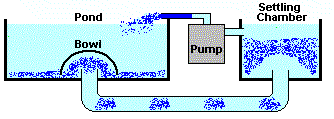 Should I consider a bottom drain ? Bottom drains are mainly for the medium to large ponds (1000 gallons and up). Draining and cleaning large ponds can be difficult and time consuming, not to mention the amount of water you waste by draining them, and the stress you cause your fish and plants. If your are looking for a low maintenance pond, I would definetly reccommend a bottom drain. Im going to put in a bottom drain, but how many? How far apart? Flow rate? A minimum flow rate of 1000 gph. How many and how far apart depends on the shape of your pond bottom. If your pond slopes to one central point you may only need one drain. If you have a completely flat bottom, you may need several, spacing would be dependant on the flow rate. Can I connect my bottom drain directly to my pump ? Yes, you can, but I wouldn't do it. Your pump would be clogged virtually every hour. A settling chamber is much better, because it allows the bigger particles to settle and not clog the pump. It also provides a safe haven for little fish that swim into the bottom drain. How much will a bottom drain cost me ? There are several popular commercial models of bottom drains available in the market. I will show you how to build a suitable replacement for a fraction of the cost.
|
||||||||
